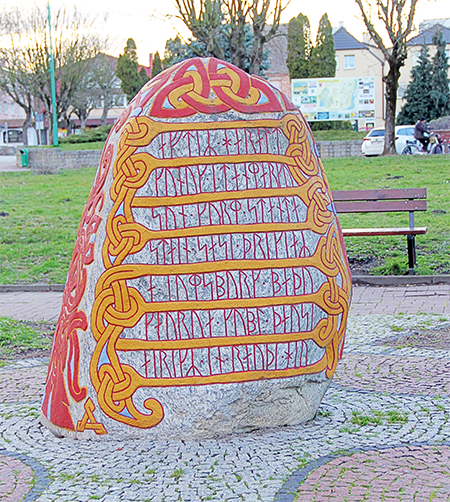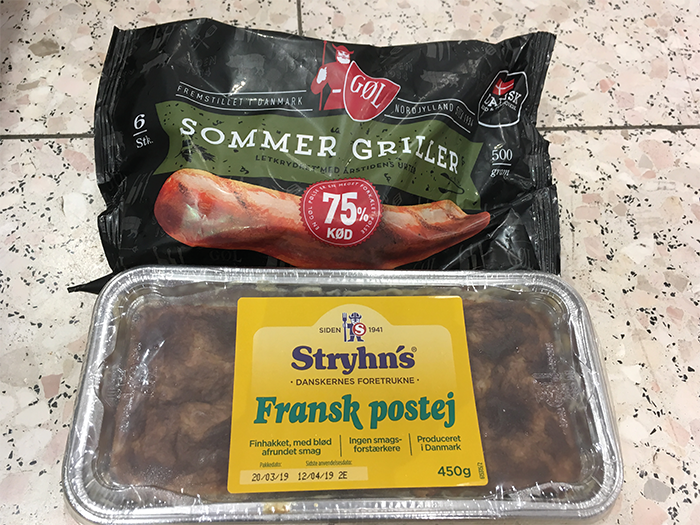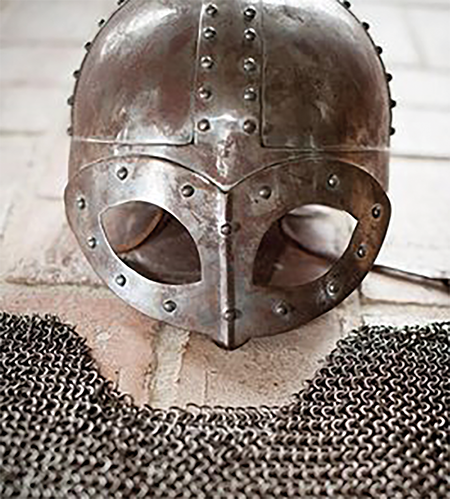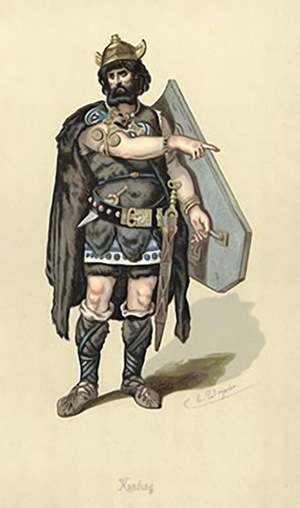1.3 Perception of Vikings
Anne Brædder, Juhan Kreem, Paweł Migdalski, Giedrius Janauskas
The Viking Age – a present past in popular culture
In 2013 the TV series Vikings premiered first in Canada and United States and then elsewhere. It soon became very popular in both Europe and North America and several seasons followed. It was written by the English screenwriter and producer Michael Hirst for the Canadian History channel. The series is inspired by the historical tales about the legendary Danish king Ragnar Lodbrog. In the series, Ragnar Lodbrog lives somewhere in Scandinavia but goes on brutal raids to England with his supporters. In the TV series, the Vikings are portrayed as bloodthirsty barbarians who rape and kill everywhere they go. This image is far from the rather playful and simplistic representation of Vikings on children’s clothes, food and in souvenir shops you can spot around the Baltic Sea.
The Viking Age is also a present past in other parts of popular culture such as reenactment. Reenactors simulate the lives and battles of Vikings in most parts of the world. Viking reenactment often consists of staging of battles, crafts and everyday life in a market. As many other reenactors, Viking reenactors take pride in their presentations; they strive for what they perceive as historical accuracy often in terms of appearance, and they pay attention to details and historical knowledge. Reenactors are most often amateur historians – meaning they are not professional or trained historians but very dedicated to their hobby.
Many museums in the Baltic Sea Region exhibiting the Viking Age also use elements of reenactment or living history. In Estonia, visitors in the Viking Village can experiment with the Viking Age for themselves and try out the work in the smithy, sail on a Viking ship, learn skills as warriors, cook over an open fire, etc. The Viking Village in Lithuania invites visitors to listen, see, feel, touch, smell and taste Viking Age heritage. In Denmark, people can visit the Viking Ship Museum where five Viking ships that were found by maritime archaeologists in 1962 are on display. The Viking Ship Museum reconstructed the Viking ship The Sea Stallion from Glendalough at the beginning of the millennium for historical research purposes. The ship was originally built in the vicinity of Dublin but was reconstructed in Roskilde, Denmark. The reconstruction can also be seen as a type of reenactment or experimental re-doings. In Stockholm, Sweden, you can visit the world’s largest Viking exhibition.
As the spectrum for representations of Vikings is wide, this chapter is divided into two parts - different perceptions of Vikings in primary sources and some aspects of Vikings in our contemporary culture.
Viking raids in Britain
The first Viking raids to England took place in the 8th century. The raids were followed by an attempted conquest in the 9th century and, for a time, the Vikings controlled large parts of England.
Anglo-Saxon chronicle was collected probably in the 9th century and is a collection of annals written in Old English. It has survived in many different manuscripts. It is indisputably an important source of early English history, but not wholly reliable.
- A.D. 793. In this year, dire forwarnings came over the land of the Northumbrians, and terrified the people; these were excessive whirlwinds, and lightning and fiery dragons were seen flying in the air. A great famine soon followed these signs; and shortly thereafter, in the same year, on the 6th before the Ides of January, the ravaging of heathen men lamentably destroyed God's church at Lindisfarne through rapine and slaughter. And Siga died on the 8th before the Kalends of March.
- - The Anglo-Saxon chronicle
Estonian Vikings
In the standard works on the Viking Age, eastern Baltic lands are not usually considered Viking territories. On the other hand, Estonians often identify the Iron Age inhabitants of their lands as Vikings. Located on the Vikings’ route to the East (Austrvegr), eastern Baltic lands were obviously in the sphere of influence of Scandinavian culture. Furthermore, the 13th century crusading chronicles describe the maritime raids of Osilians, making it easy to place them in the same context as the Viking raids to western Europe a few centuries earlier. In the Estonian national history, this also made it possible to envisage a glorious past, which also included the destruction of Swedish Sigtuna in 1187. This notion of a “glorious Viking past” inspired Estonian writers in late 1920s and 1930s to write novels such as Urmas and Merike.
The destruction of Sigtuna by the easterlings is recorded in the Erikskrönikan (Chronicle of Duke Eric), written c. 1320. In early modern history writing, other Eastern nations are also mentioned as responsible for burning down the town. That these nations were Estonians is picked up in the first speech to fatherland by Carl Robert Jakobson in 1868, and since then has been firmly anchored in Estonians’ cultural memory.
- Sweden then suffered serious harm,
- From the Karelians, causing great alarm.
- They sailed into Lake Mälar from the sea,
- Whether calm or stormy it might be,
- Secretly within the Svealand isles
- In stealthily advancing files.
- Once their minds to the idea did turn,
- That they the town of Sigtuna should burn,
- And so thoroughly they put it to the flame,
- That it since then has never been the same.
- There Archbishop Jon was killed,
- A deed that many a heathen thrilled.
- - The Chronicle of Duke Eric. Verse epic from medieval Sweden. Translated by Eric Carlquist & Peter C. Hogg. Lund, 2012.
Carl Robert Jakobson (1817-1857), journalist, politician and author of influential school textbooks, was one of the leaders of the Estonian national movement. His three speeches to the fatherland formulated the view of history that interpreted the pre-conquest period in Estonian history as a golden age.
- In 1188 [sic!] the Estonians [!] sailed to Sweden to the lake of Mälar, which was under the Danish rule at that time, and killed there on the 1st of June the Archbishop Johann of Uppsala, and burned down the large city of Sigtuna, whereafter the new capital Stockholm was established. Even nowadays the large ruins and towers of Sigtuna between Stockholm and Uppsala are marvelled at, and it is difficult to believe how with the insufficient weaponry of the time, the Estonians could have destroyed such powerful city. But among the Swedes still goes the tale about the destruction of Uppsala, and about the boldness of Estonians.
- - Carl Robert Jakobson. Kolm isamaa kõnet (Three speeches to the fatherland). St Petersburg, 1870.
Vikings in the history of the foundation of Rus
Russian Primary Chronicle, the Tale of Bygone Years, narrates how the Slavs invited three brothers, Rjurik, Sineus and Truvor to rule over them in second half of the 9th century. Rjurik established himself in Novgorod, his son Oleg also conquered Smolensk and Kiev, thus laying foundation to the Kiev Rus. The exact role of the Scandinavians in establishing this first Russian state is a hotly debated issue. On the one hand, there is no doubt about the presence of the Scandinavian military elites in Kiev Rus. On the other hand, in the Russian nationalist historiography, a strong trend of anti-Normanism has prevailed, which insisted that the formation of the state was a result of local development, and the Viking (Varangian) immigrants were rapidly assimilated.
- There was no law among them, but tribe rose against tribe. Discord thus ensued among them, and they began to war one against another. They said to themselves, “Let us seek a prince who may rule over us and judge us according to the Law.” And so they accordingly went overseas to the Varangian Russes: These particular Varangians were known as Russes, just as some are called Swedes, and others Normans, English, and Gotlanders, for they were thus named. The Chuds, the Slavs, the Krivichians, and the Ves’ then said to the people of Rus’, “Our land is great and rich, but there is no order in it. Come to rule and reign over us.” They thus selected three brothers, with their kinsfolk, who took with them all the Russes and migrated. The oldest, Rjurik, located himself in Novgorod; the second, Sineus, at Beloozero; and the third, Truvor, in Izborsk.
- - The Russian Primary Chronicle. Laurentian Text. Translated and edited by Samuel Hazzard Cross and Olgerd P. Sherbowitz-Wetzor. Cambridge, 1953. P. 59.
Vikings in the History of Lithuania
Arturas Mickevičius studied the influence of the Vikings on eastern Baltic society with special regard to the beginnings of statehood in Lithuania. Mickevičius was interested in the Curonians as possibly being the Baltic Vikings or perhaps as a defence against the Viking raids.
Description of Viking and Curonian battle (853) in Seeburg (present-day Grobiņa, Latvia) and Aputra (Apuolė, Lithuania) described in Rimbert’s Life of Anskar, the Apostle of the North, 801-865 (Vita Sancti Anscari).
- CHAPTER XXX.
- [...] The Danes, being aware of this, at the time when the bishop had come into Swedish territory, collected a large number of ships, and proceeded to this country [Curonia], eager to seize their goods and to subject them to themselves. Their kingdom contained five towns. When the inhabitants knew of their coming they gathered together and began to resist manfully and to defend their property. I having obtained the victory they massacred half the Danes and plundered their ships, obtaining from them gold and silver and much spoil. On hearing this, King Olaf and the Swedes, who wished to win for themselves the reputation that they could do what the Danes had not done, and because this people had formerly been subject to them, collected an immense army and proceeded to these parts. In the first instance they came to a town in their kingdom called Seeburg. This town, which contained seven thousand fighting men, they ravaged and despoiled and burnt. They left it with strengthened hopes and, having sent away their ships, set out on a five days journey and hastened with savage intent to another of their towns called Aputra in which there were fifteen thousand fighting men. When they reached it, these were shut up in the town, and whilst the one party vigorously attacked the town from outside, the other party defended it from within. In this way eight days went by with the result that, though they fought and waged war from morning till night, and many fell on both sides, neither side obtained the victory. On the ninth day the Swedes, being exhausted by the daily slaughter, began to be distressed, and in their terror considered only how they might get away. [...] when the Swedish King had agreed, they immediately said, "We desire peace rather than fighting, and we wish to enter into an agreement with you. In the first place we are prepared to give you for the sake of securing an agreement all the gold and the arms that we took as spoil from the Danes last year. Furthermore, we offer half a pound of silver for each individual man now in this town, and in addition we will pay you the tribute which we formerly paid and will give hostages, for we desire henceforth to be subject and obedient to your rule, as we were in former time. [...].
- - Can be retrieved from: https://sourcebooks.fordham.edu/basis/anskar.asp
Questions for reflection and discussion (1)
- The Vikings have been portrayed both as barbaric raiders and destroyers but also as establishers of states. What has made the Viking past so attractive throughout history?
- Compare the different primary sources - find the similarities and the differences of their portrayals. Think about why a certain source should choose to portray the Vikings in that specific way.
Vikings and the establishment of the Polish state – the case of Wolin
The question of the role of the Scandinavians in establishing this first Polish state is still an important point of debate for Polish historians. This thesis was put forward in 1918 by German historian Robert Holtzmann. He indicated that the first historic ruler of Poland, Mieszko I, was a Viking, known in one document by the name Dago. In the following years, many German researchers supported this thesis, while a main aim of Polish medieval studies of the interwar-period became to debunk it. The key of this discussion was the fact that Wolin lay in the mouth of the Odra, at the crossroads of Polish and Scandinavian influences. German researchers proved that this settlement had been German-Viking city, while Polish historians suggested that it had been Slavic and dependent on the Piast dynasty.
Polish excavations in Wolin after 1952 had to prove either the Polish or Slavic character of this port of trade. After the political transformation in 1989, historians and archaeologists quite openly thought that this settlement had foreign and not Slavic merchants (who were mentioned in the chronicle of Adam of Bremen in the 11th century), among them also Scandinavians, traces of whom are examples of runes and the ornaments in the borre style. In the 21st century, local reenactors built the Skansen museum, which is the stage for the Festival of Slavs and Vikings (one of the largest Viking festivals in the world) who dominate this event. In 1993, the city placed a runic stone on the city square in commemoration of Harald Bluetooth. It was replaced in 2014 by a new monument, a painted runic stone similar to the Jelling Stone.

The horned Viking as a national symbol around the Baltic Sea
The horned Viking is a national symbol for several countries in the Baltic Sea region. If you enter a souvenir shop in Denmark, Sweden, Estonia or Poland, you’ll find images on cups, magnets, t-shirts, etc. of Vikings and little figurines representing Vikings. As you saw from the primary sources, the Viking Age is an inevitable part of Danish, Swedish or Estonian history, and as it is a great part of the national identity of those countries, it is to be found in souvenir shops.
The Vikings are often portrayed wearing helmets with horns. The horned helmets are the defining feature of the representation of Vikings. At national sport events like football or handball games, Danish and Swedish sports fans wear horned Viking helmets or fur caps shaped like Viking helmets with horns in their national colours red/white and blue/yellow. In many souvenir shops or toy shops, you can buy your own Viking helmet with horns. Many Danish brands use the horned Vikings as part of their marketing, selling for instance either the Danish specialty liver pâté, sausages or expensive children’s clothes. The horns are a clear symbol of Vikings. Thus, it might come as a surprise that the Vikings did not actually have horns on their helmets. It is a myth that has existed since the 19th century and persists even though historians and archaeologists have known for more than 100 years that this was not the case.

Archaeologists have found only a few helmets from the Viking Age and none with horns. Horned helmets were used in Scandinavia earlier than the Viking Age. In the Danish National Museum, you can see two helmets with horns, but they are from the Bronze Age. The museum has one helmet from the Viking Age and it has no horns. The few helmets we know of from the Viking Age show that the Vikings wore helmets that could protect them when they went to war or on raids. The helmets protected the upper part of the head and often had different types of protection for the nose and the neck.

So, why did Viking helmets become horned one might ask. In the 19th century, artists, historians and archaeologists were especially interested in Nordic history from 800–1050, and by the end of the 19th century, this period had become known as The Viking Age. German artists and intellectuals in particular connected Vikings with the much older Germanic culture. Within this culture, the Teutons were portrayed with horns and this, in turn, affected the representation of Vikings. In the late 1800’s, the horned Vikings spread in European literature and art. This image from foreign countries influenced the Nordic culture where Vikings began to be portrayed with horns and have been ever since.

Questions for reflection and discussion (2)
- Based on the two case studies, how have 19th and 20th century historians influenced the way we see the Vikings today?
- How (if at all) is this different from what you read from the primary sources? What does that imply about the values we consider important in today’s society?
Further reading
- Kasper Holdgaard Andersen. MYTE: Havde vikingernes hjelme horn? (2016): https://danmarkshistorien.dk/leksikon-og-kilder/vis/materiale/myte-havde-vikingernes-hjelme-horn/. (visited 14th of November 2018)
- Jan Bill. Welcome on board! – the Sea Stallion from Glendalough: a Viking longship recreated. Viking Ship Museum, 2007.
- Linda Kaljundi. “Challenging expansions: Estonian Viking novels and the politics of memory in the 1930s.” In: Novels, Histories, and Novel Nations: Historical Fiction and Cultural Memory in Finland and Estonia. Ed. by Linda Kaljundi, Eneken Laanes, Ilona Pikkanen. Helsinki, Suomalaisen Kirjallisuuden Seura, 2015. Pp. 182−207.
- Arturas Mickevičius. Vikingai Lietuvos istorijoje (Vikings in the History of Lithuania). Studija Versus, 2019.
- Marika Mägi. In Austrvegr: the role of the Eastern Baltic in Viking Age communication across the Baltic Sea. Leiden, Brill, 2018.
- Scandinavian Culture in Medieval Poland. Ed. by Sławomir Moździoch, Błażej Stanisławski, Przemysław Wiszewski. Warszawa: IAE PAN, 2013.